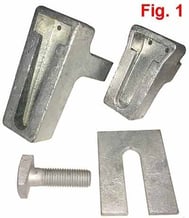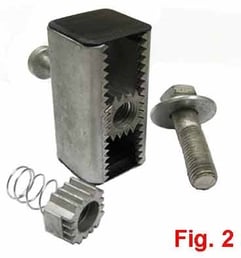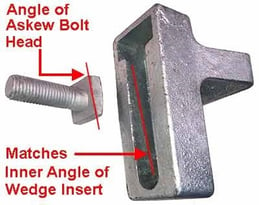Note: This article will refer to the WEDGE INSERT. (See Fig. 1) The same product is also known as a Relieving Angle Insert, Shelf Insert, Concrete Wedge Insert, Brick Relief Angle Insert and/or Malleable Iron Wedge Insert.
 Both the Wedge Insert and the Sharktooth Insert (Fig. 2) perform a similar function. They provide an anchoring system to connect heavier loads to concrete. Depending upon the application and how they are mounted, they may be completely obscured once the project is finished and present no interruption in the visual appeal of the structure.
Both the Wedge Insert and the Sharktooth Insert (Fig. 2) perform a similar function. They provide an anchoring system to connect heavier loads to concrete. Depending upon the application and how they are mounted, they may be completely obscured once the project is finished and present no interruption in the visual appeal of the structure.
Lighter loads and situations where aesthetic appeal is not a factor can be handled less expensively with standard channel. Ranging from 12 gauge to 18 gauge standard channel can be used to anchor electrical, light plumbing fixtures, etc.
For supporting heavier structural members, anchoring systems with higher tensile and yield strengths are required. The most basic system is pouring concrete with no anchor in place, drilling after the fact and installing epoxy embeds. This can be time consuming, expensive and difficult to do as accurately as desired.
(Note: this same logic holds true with our EZ Sleeves when setting handrails. Click here to view)
 With some investment of time beforehand, Concrete Anchors can be placed to provide a very strong connection, allow for adjustment to assure near perfect alignment, accuracy and ultimately offer significant cost savings.
With some investment of time beforehand, Concrete Anchors can be placed to provide a very strong connection, allow for adjustment to assure near perfect alignment, accuracy and ultimately offer significant cost savings.
The two systems available in these cases are the Wedge Insert (Fig. 1) and the Sharktooth Insert (Fig. 2).
Wedge Insert
Both the Wedge Insert and the Sharktooth Insert are embedded the same way. They are secured in place prior to the concrete slab being poured. The main difference is a Wedge Insert has a “loop” in the back to attach Hairpin Rebar. The Sharktooth Inset has a Weld Stud already in place and requires no additional anchoring. Once the concrete slab is cured, the forms are removed and all that is visible is the face.
For a review with illustrations of the Wedge Insert installation, click here. (7 pages)
 An Askew Head Bolt is then inserted into the cavity. The matching angled slopes allow the bolt to protrude from the Wedge Insert at 90°. See photo “Angle of Askew Head Bolt.” The angle is very important in the function of this anchoring system. Once the bolt is tightened and the load is applied, the angle will resist any downward slipping. If any slip does occur, the bolt is then tighter, due to the widening of the Wedge Insert face.
An Askew Head Bolt is then inserted into the cavity. The matching angled slopes allow the bolt to protrude from the Wedge Insert at 90°. See photo “Angle of Askew Head Bolt.” The angle is very important in the function of this anchoring system. Once the bolt is tightened and the load is applied, the angle will resist any downward slipping. If any slip does occur, the bolt is then tighter, due to the widening of the Wedge Insert face.
Those two factors combine to make the connection very secure. This understanding of how a standard Wedge Insert works shows that it should only be mounted vertically. The load can be in any direction desired, but the force exerted by that weight should be downward to allow the insert to function at proper strength.
Sharktooth Insert
The first thing to note about the Sharktooth Anchor system is that due to the way it functions, it can be any length, from 3” to 144”. Sections can be run, end to end, to continue indefinitely.
The open face of the Sharktooth Anchor has serrated along the edges in the heavy steel casing. The Sharktooth Insert has matching teeth on its exterior. Note in Fig. 2 the insert has teeth the full length on one side, and half-length teeth one the other side. This system allows the insert to pass through the teeth in the Anchor, rotate 90° and lock in place. The backing spring provides pressure to hold it in place. The insert is internally threaded to 3/4-10 UNC pitch for Hot Dip Galvanized bolts or threaded rod.
In the case of the Sharktooth Anchor, the interlocking teeth holding the insert in place will not allow for slipping. This advantage allows the Sharktooth Anchor to be mounted in any direction and still achieve the same strength.
Summary
The advantage of the Sharktooth Anchor and Sharktooth Insert is they can be positioned in any direction including overhead facing down. The inserts can be placed at any intervals so positioning is much more flexible. Depending on the application, installation of the steel members can require less time and provide labor savings.
The advantage of the Wedge Insert is its much lower cost. Once placed upright and accurately in the concrete slab, they will provide the necessary strength, leave room for vertical adjustment (horizontal adjustment is provides with a slot in the relieving angle) and do so for approximately half the cost per location as the Sharktooth Anchor.





